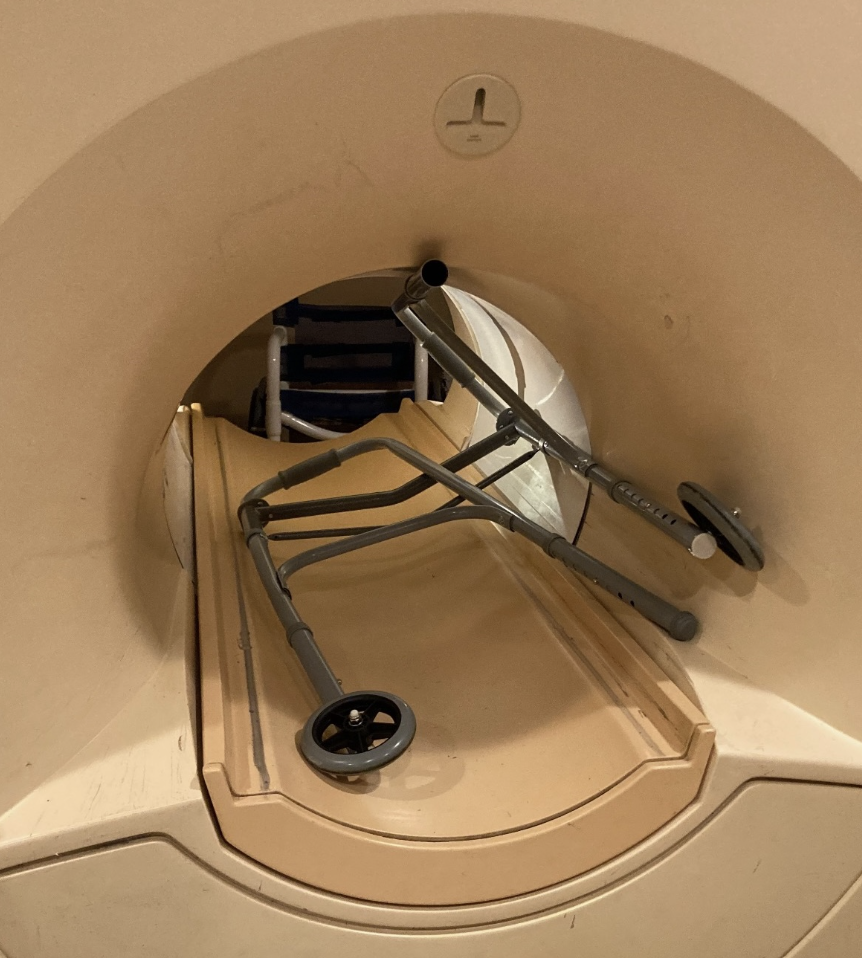When Precision Becomes Critical: Why Imaging System Repairs Demand Qualified Engineers (05.12.25)
A recent safety incident at a customer site served as a stark reminder of the invisible but ever-present risks involved in servicing medical imaging equipment. In the image above, a metal walker was inadvertently brought into the magnetic field of an MRI scanner—pulled into the bore with dangerous force. Thankfully, no one was hurt. But the event could have easily ended differently.
This real-world example underscores a vital truth: repairing medical imaging machines is not a job for the untrained or unfamiliar. It’s not just about knowing how the machines work—it’s about understanding the strict environmental, electromagnetic, and physical safety protocols that surround them.
At Imaging Service Solutions, we specialize in the precise, safe, and compliant servicing of diagnostic imaging systems like MRIs, CTs, and X-ray machines. Our engineers are trained not only in the technical mechanics of these machines but also in the nuanced safety procedures required to operate around them. Here are three strong reasons why this matters—and why you should always turn to a qualified engineering team.
1. Safety Hazards in Magnetic Fields Are Inescapable—And Instant
Magnetic Resonance Imaging (MRI) systems operate using high-powered magnetic fields—many times stronger than what most people experience in day-to-day life. These magnetic fields are always active, even when the machine is not in use. Bringing ferromagnetic objects near the bore of an MRI scanner—such as tools, oxygen tanks, or walkers—can have catastrophic consequences.
An object as seemingly benign as a metal clip or cart can become a deadly projectile once inside the fringe field of an MRI. This danger is invisible but ever-present. Engineers at Imaging Service Solutions are trained to adhere to strict zone protocols and use MRI-safe equipment. They understand the radius of influence of the magnetic field, how to identify and remove unsafe items, and how to work within the suite without endangering themselves or others.
2. Regulatory Compliance and Site Safety Standards Must Be Met
Medical facilities operate under rigorous standards set by OSHA, The Joint Commission, and device-specific safety protocols from manufacturers. Non-compliance—whether intentional or accidental—can lead to legal liability, patient harm, equipment damage, and expensive downtime.
Imaging Service Solutions engineers are thoroughly trained in OEM protocols, shielding integrity, low-voltage systems, and EMI/RFI compliance—especially important in shielded rooms like MRI suites. Their familiarity with site-specific build-outs, proper deactivation and restart procedures, and the use of non-ferrous tools prevents not only safety hazards but also imaging artifacts or system calibration errors that can affect diagnostic quality.
3. Improper Repairs Can Compromise Imaging Accuracy and Patient Outcomes
Even minor repair errors in imaging systems can have major downstream effects. A misaligned gantry, a poorly shielded cable, or a non-compliant lighting fixture can all introduce signal interference or distortions that compromise the quality of diagnostic imaging. These errors might not be immediately obvious but can lead to misdiagnosis, patient recalls, or even liability exposure.
Imaging Service Solutions engineers go beyond fixing the issue at hand—they perform comprehensive checks, confirm proper shielding, test output quality, and recalibrate the machine to manufacturer standards. Their focus on the whole system ensures that the repairs don’t just restore function but maintain diagnostic integrity and regulatory compliance.
Conclusion
Servicing and repairing imaging equipment—especially MRI machines—is not just a matter of technical know-how. It’s about working safely in one of the most complex and sensitive environments in healthcare. The risks are high, and the margin for error is slim.
By choosing Imaging Service Solutions, healthcare providers gain more than just technical support—they gain peace of mind. Our engineers are not only trained, experienced, and certified—they’re committed to protecting patients, staff, and the imaging investment itself.
Because in this field, safety isn’t just important. It’s non-negotiable.

